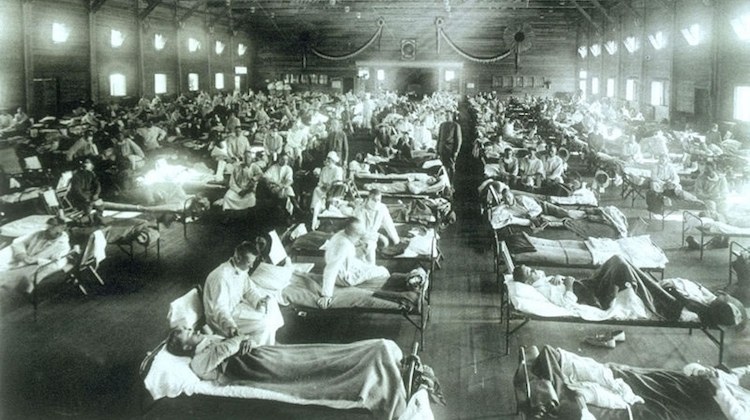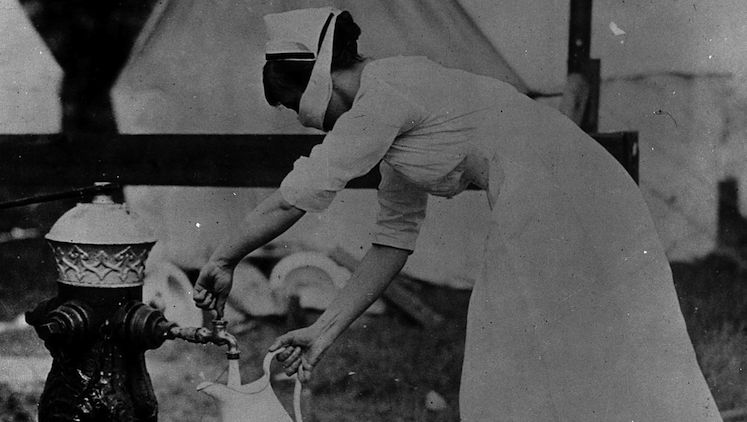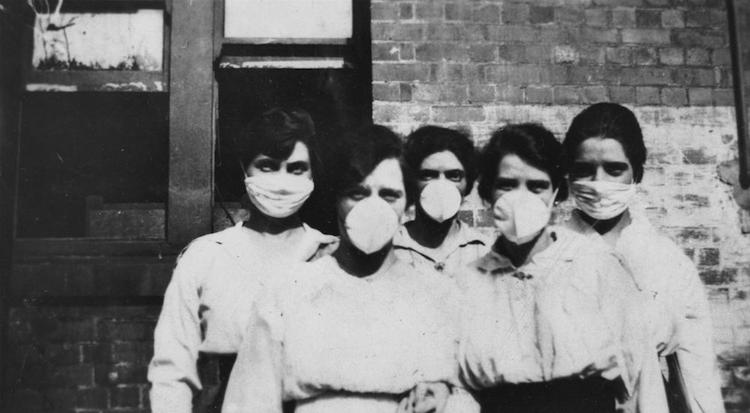 As we commemorate Armistice Day, Vanessa Lafaye looks back on the devastating fallout of the First World War – and the unseen enemy waiting in the wings.
As we commemorate Armistice Day, Vanessa Lafaye looks back on the devastating fallout of the First World War – and the unseen enemy waiting in the wings.
With the cruelest of ironies, even as the Armistice bells were ringing in every town and village, another attack was under way. The enemy wore no uniform, was invisible to the eye, and was carried on the very air the troops breathed. It recognised no national allegiances, striking with deadly force at combatants from all nations, and civilians alike. Its victims—mostly the fit and the young—died in agony as their lungs dissolved, the only mercy the swiftness of their demise. The few, the lucky survivors of the combat, which had killed so many of their comrades, could feel well at breakfast time, and be dead by the evening. More American soldiers died of this than died in the fighting.
The Spanish Flu, known as ‘la gripe’ in France, was so named because neutral Spain was allowed to report on the devastation caused by the disease, while the countries involved in the conflict suppressed the news over fears of its effects on morale. In 1918 alone, the virus killed an estimated 50,000,000 people worldwide—6% of the global population, and four times as many as died of the Black Plague over four years. It remains the largest pandemic in recorded history.
 Medicine at that time was helpless. Doctors doled out whiskey and aspirin to ease suffering, but there was no effective treatment, and so the emphasis switched to infection control. No one could explain why the strain of flu was so virulent, or why it spread so quickly; neither could they explain why some patients survived, when this flu had a mortality rate 25 times that of previous strains. It is generally agreed by scientists that it was a bird flu from China, possibly brought by Chinese workers, which found a perfect home in the crowded, dirty conditions of the battlefield camps. From there, it spread to virtually every country where the soldiers were repatriated: the heroes brought death home with them.
Medicine at that time was helpless. Doctors doled out whiskey and aspirin to ease suffering, but there was no effective treatment, and so the emphasis switched to infection control. No one could explain why the strain of flu was so virulent, or why it spread so quickly; neither could they explain why some patients survived, when this flu had a mortality rate 25 times that of previous strains. It is generally agreed by scientists that it was a bird flu from China, possibly brought by Chinese workers, which found a perfect home in the crowded, dirty conditions of the battlefield camps. From there, it spread to virtually every country where the soldiers were repatriated: the heroes brought death home with them.
I became interested in this aspect of the end of the war because, for all its catastrophic impact on the world, it seemed somewhat under-emphasised in historical fiction of the period. During my research for my novel, At First Light, I learned a lot about the disease itself, but also discovered that there was a second, lesser-known outbreak of the same virus a year later, in 1919—which happened to be the year in which the novel is set.
I started to wonder what it would have been like for the soldiers, who had survived so much horror, to be struck by something deadlier than any human foe, just on the point of victory. The despair amongst the medics must have also been intense, as they were completely worn out by dealing with the wounds of war, and utterly powerless to save those infected. And then, only a year later, people had to face the same disease again, although on a smaller scale…it must have been terrifying. The disease not only devastated a generation that had lost so much–with whole families being wiped out in a single day–but babies born to survivors suffered a higher incidence of learning disabilities too.
 My character, John Morales, is one of these returning soldiers, who arrives back home in Key West, Florida in 1919. The disease throws him together with the other main characters. A survivor of the flu himself, his life is changed dramatically by the second outbreak when he meets mixed-race Alicia, banished in disgrace from her home in Cuba. John’s intervention also alters the destiny of young Dwayne (the Deputy Sheriff from my first novel, Summertime, set in 1935). Dwayne in turn will be instrumental in deciding John’s fate.
My character, John Morales, is one of these returning soldiers, who arrives back home in Key West, Florida in 1919. The disease throws him together with the other main characters. A survivor of the flu himself, his life is changed dramatically by the second outbreak when he meets mixed-race Alicia, banished in disgrace from her home in Cuba. John’s intervention also alters the destiny of young Dwayne (the Deputy Sheriff from my first novel, Summertime, set in 1935). Dwayne in turn will be instrumental in deciding John’s fate.
There is another reason to be interested in this episode, aside from its historical significance. Even today, no one knows why the disease arrived when it did, or—most frighteningly—how to stop it if it were to occur again. Despite all the advances in modern medicine, we are no better prepared to deal with this disease now, and modern air travel would allow it to spread even more quickly than it did 100 years ago.
The Armistice brought an end to four years of bloodshed, but for some people, the battle was far from over.
Vanessa Lafaye is the author of Summertime, which was shortlisted for the HWA Goldsboro Debut Crown Award. At First Light is published by Orion on 1 June, 2017.
Read our interview with Vanessa.
This article first appeared on The Prime Writers website.




